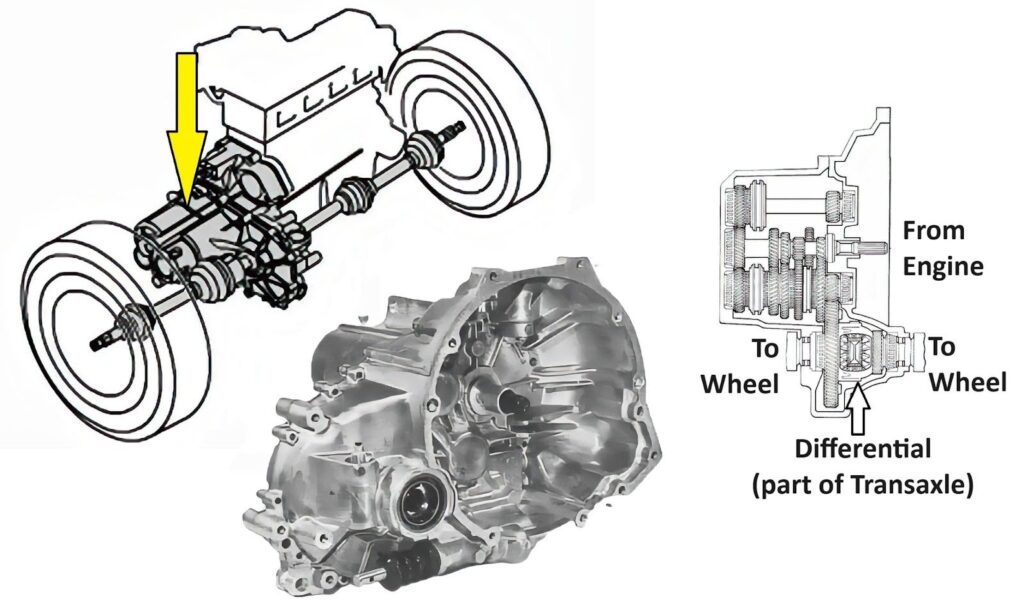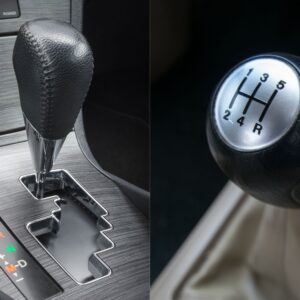Not all vehicles have transaxles. Those that do are usually front-wheel drives. But why is that the case, and why are they considered a crucial part of the transmission system?
What is a Transaxle in a Car?
The transaxle is a combination of the transmission and differential in one assembly. It draws power from the engine and allocates it to the drive wheels.

Transaxles are an important component of any vehicle that uses front-wheel drive — or any vehicle where the engine and drive wheels are on the same side.
The transaxle is typically between the drive wheels, meaning you’ll have to raise the vehicle with jack stands to access it.

Can You Drive with a Bad Transaxle?
For safety reasons, driving with a bad transaxle is not recommended. But the answer may also depend on the actual problem with the transaxle and what symptoms you observe. Is the transaxle making whining noises? Do you feel any vibration? If it is an automatic transaxle, is it slipping or does it engage harshly when you put it in gear? If it’s a manual transaxle, do you get gear clash when you shift from one gear to the next?
Regardless, it’s best to have a bad transaxle repaired or replaced as soon as possible.
Signs of a Bad Transaxle
The symptoms of a bad transaxle include difficulty in shifting gears, noises in the transaxle housing, and transmission slipping. If your vehicle displays any of these warning signs, it might be time to get your transaxle checked by a mechanic.
Difficulty Shifting Gears
Jerky, clunky transmission clutches are a sign that there’s something wrong with the transaxle.
If the gear stick feels stiff, there might not be enough lubrication in the transmission. It could also mean something’s damaged the transmission system.
Noisy Transmission System
Grinding, high-pitched noises from the transmission could mean there’s damage in the transaxle, usually because of friction. When parts grind against one another, it creates a shrill whining noise.
Transmission Slipping
A transmission clutch that slips and shifts gears too easily can be just as dangerous as a clutch that refuses to change gears. Either way, unreliable clutches could indicate that the transaxle is malfunctioning.
How Do Mechanics Perform Transaxle Lubricant Checks?
While it is technically possible to check the level of transaxle lubricant yourself, it’s usually best to leave it to a professional.
Mechanics know what type of fluid to use on a vehicle depending on its make and model. There are four different kinds of lubricants to keep in mind.
- Gear lube, such as SAE 80W-90
- Engine oil, such as SAE 5W-30
- Manual transmission fluid (STF) or synchromesh transmission fluid
- Automatic transmission fluid (ATF)
If you’re curious about lubricant checks, here are the steps mechanics usually take to conduct one.
- Lift the vehicle with jack stands or a car hoist. Ensure it remains level at all times.
- Check the fluid level by removing the transmission/transaxle inspection (fill) plug.
- Determine if the level of transaxle lubricant is correct by checking if the fluid drips out of the hole. If the fluid runs out of the hole, the level is too full and must flow out until the fluid stops.
- If the transaxle lubricant levels are low, determine which fluid to use on the vehicle before filling it. Then, fill the hole until the fluid level is at the bottom of the inspection hole or until the fluid runs out of the inspection hole.
- Reinsert the fill plug and lower the vehicle from its elevated position.

Frequently Asked Questions
Here are the answers to some of the most commonly asked questions about the transaxle.
Do all vehicles have transaxles?
No, not all vehicles have transaxles. Transaxles are in most modern vehicles, but they’re typically not a part of rear-wheel drive vehicles. It just so happens that most vehicles nowadays use front-wheel drive drivetrains, which need transaxles.
Can rear-wheel drive vehicles have transaxles?
Yes, rear-wheel drive vehicles can have transaxles. Transaxles can work with any vehicle where the engine and the drive wheels are on the same end of the car. This is because transaxles are both the transmission and the differential.
How long does the average transaxle last?
Without maintenance, a transaxle can last roughly seven years or approximately 100,000 miles. If the transmission is properly taken care of, the transaxle might never need replacement.
What is a transaxle control module, and is it the same as a transmission control module?
Transaxle control modules are not the same as transmission control modules because they don’t exist. Transmission control modules control all the operations of the transmission of a vehicle.
Get High-Quality Automatic Transmission Clutch Parts For Your Car
In automatic cars, the transmission clutch consists of multiple parts, such as the automatic transmission clutch drum, automatic transmission clutch hub, and automatic transmission clutch plate. Here at CarParts.com, you can get replacements for the automatic transmission clutch parts you can rely on.
CarParts.com is your one-stop shop for automatic transmission clutch drums, clutch hubs, and clutch plates. We believe you deserve long-lasting parts that deliver world-class performance, so we exclusively source our products from companies trusted by drivers across the US. Finding a compatible automatic transmission clutch drum, hub, or plate in our extensive catalog of parts and accessories is easy. Simply plug your vehicle’s details, such as its year, make, model, and engine, into our website’s built-in vehicle selector. Ordering your new part takes only a few taps on your mobile phone’s screen, and it arrives at your doorstep in only several business days if you live in the continental US and order before 12 p.m.
So, what are you waiting for? Visit CarParts.com and browse our selection of automatic transmission clutch drums, automatic transmission clutch hubs, and automatic transmission clutch plates.Get yours today.
Any information provided on this Website is for informational purposes only and is not intended to replace consultation with a professional mechanic. The accuracy and timeliness of the information may change from the time of publication.

































